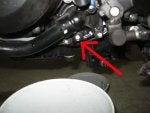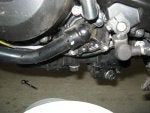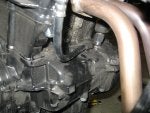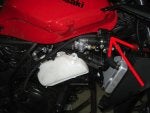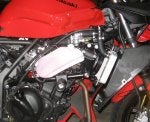Most tracks ban the use of antifreeze since it's extremely sticky and hard to clean up. Dealers usually use antifreeze since it's less corrosive than water, and (of course) has a freezing point of well below 0 Celsius. Here's how to replace your stock coolant with distilled water or, better yet, water with WaterWetter.
You will need:
- 10mm socket wrench
- 8mm socket wrench
- Everything listed in DIY Fairing Removal
- Distilled water (from your local grocery store, 3+ gallons)
- Water with WaterWetter (i use this one from Cycle Gear)
- 2 buckets
- Funnel
How to flush the coolant:
1) Follow the DIY Fairing Removal to get your bike naked.
2) Locate the first coolant drain bolt. It's at the bottom of the water pump cover on the left side of your bike, in front of the shift lever:
![Image]()
3) Place a bucket under this drain bolt, and using the 10mm socket wrench, remove the drain bolt. Be careful though -- the coolant will spray up to a foot away! Leave the bucket there as we proceed with the next steps.
![Image]()
4) Locate the second drain bolt in the cylinder housing at the front of the engine. It's right below the exhaust pipe connections:
![Image]()
5) Place a bucket under this drain bolt, and using the 8mm socket wrench, remove the drain bolt. The coolant here will leak all over the engine housing and exhaust pipes... this will need to be rinsed with water and wiped down when we're done. Leave the bucket there as we proceed with the next steps.
![Image]()
6) Now, unscrew the radiator cap (pictured below), and pour distilled water into the radiator. As you pour, the water should flow out of the two drain plugs and into the buckets. Keep pouring as long as the fluid coming out is green... i used an entire gallon of water!
![Image]()
To be continued....
You will need:
- 10mm socket wrench
- 8mm socket wrench
- Everything listed in DIY Fairing Removal
- Distilled water (from your local grocery store, 3+ gallons)
- Water with WaterWetter (i use this one from Cycle Gear)
- 2 buckets
- Funnel
How to flush the coolant:
1) Follow the DIY Fairing Removal to get your bike naked.
2) Locate the first coolant drain bolt. It's at the bottom of the water pump cover on the left side of your bike, in front of the shift lever:
3) Place a bucket under this drain bolt, and using the 10mm socket wrench, remove the drain bolt. Be careful though -- the coolant will spray up to a foot away! Leave the bucket there as we proceed with the next steps.
4) Locate the second drain bolt in the cylinder housing at the front of the engine. It's right below the exhaust pipe connections:
5) Place a bucket under this drain bolt, and using the 8mm socket wrench, remove the drain bolt. The coolant here will leak all over the engine housing and exhaust pipes... this will need to be rinsed with water and wiped down when we're done. Leave the bucket there as we proceed with the next steps.
6) Now, unscrew the radiator cap (pictured below), and pour distilled water into the radiator. As you pour, the water should flow out of the two drain plugs and into the buckets. Keep pouring as long as the fluid coming out is green... i used an entire gallon of water!
To be continued....


